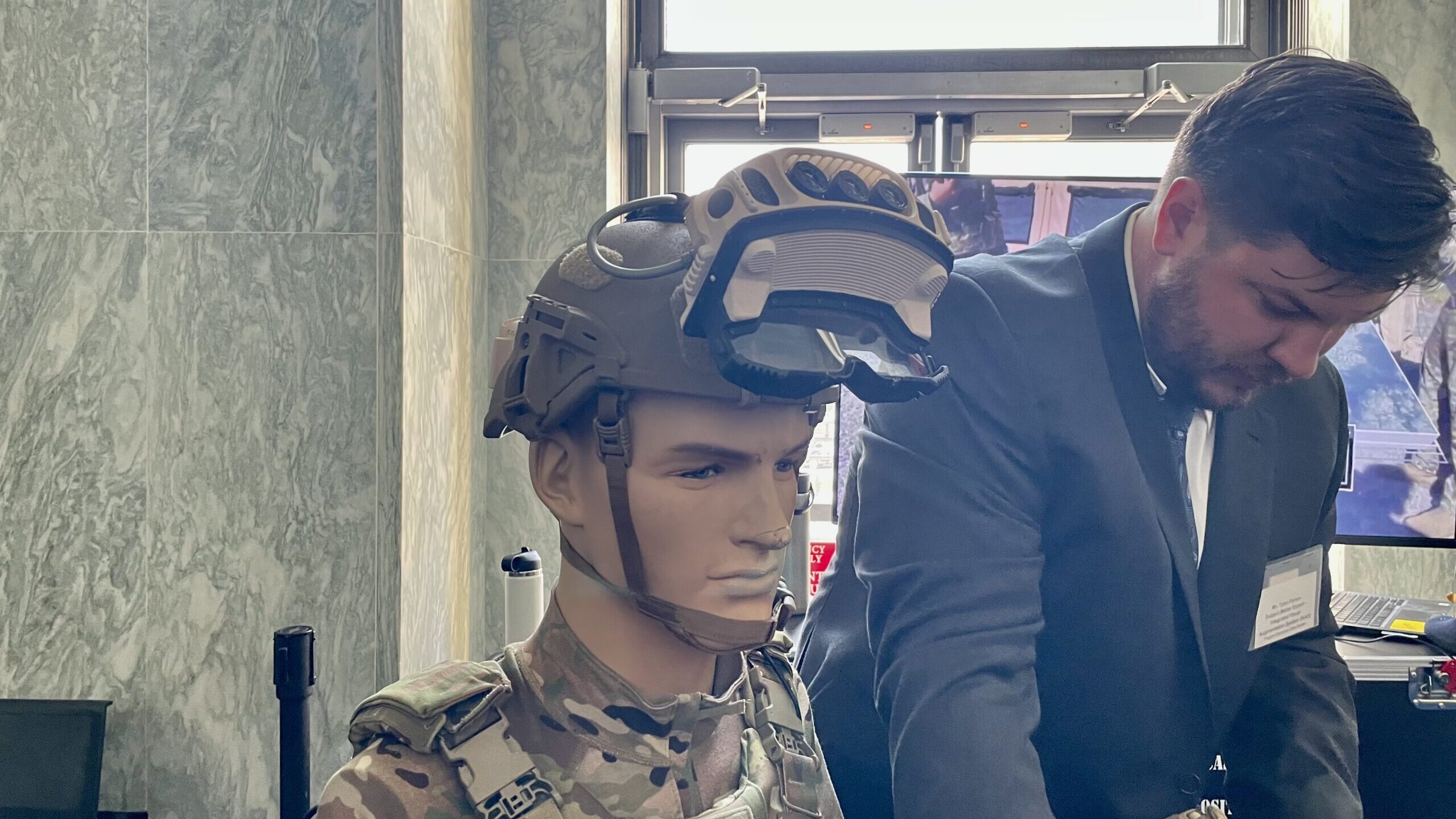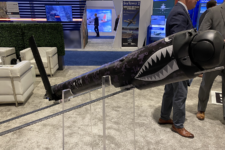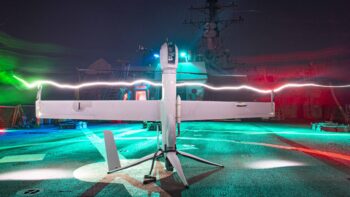
The Army displayed its new IVAS 1.2 prototype with a flip-up head-up display on Capitol Hill Wednesday night. (Ashley Roque/Breaking Defense)
WASHINGTON — Microsoft has delivered the first 20 Integrated Visual Augmentation System (IVAS) 1.2 prototypes to the Army for an upcoming test, a critical “data point” to see if design changes are enough for soldiers to safely and comfortably use the high-tech system in combat, according to multiple service officials.
If the returns on IVAS 1.2 — including the a soldier touchpoint at Ft. Drum, NY next month, which will see light infantry soldiers with the 10th Mountain Division test the system — do not meet expectations, the service will consider recompeting the program with other companies. the Army’s top acquisition official underlined.
The service received the updated, militarized version of Microsoft’s HoloLens 2 head-up (HUD) display on Tuesday, IVAS product manager Lt. Col. Denny Dresch told Breaking Defense on Wednesday. Dresch, and other Army acquisition officers, were on Capitol Hill showing off the newly delivered, working prototypes (among other technologies) to reporters, members of Congress and their staff.
Doug Bush, the head of Army acquisition, was also in attendance and billed the redesign as a step in the “right direction.” He said the upcoming test is a “very important data point,” but one that will provide the service with more subjective feedback.
“That [August test] will give us a good initial view [of] if we’re headed in the right direction, then we have to go to more and more difficult tests,” Bush told reporters.
“Wearing it [alone] like this is one thing but when you have everything else on, it has to work there too,” he added.
While the device is envisioned as technology for soldiers to also use for mixed-reality training as part of the Squad Immersive Virtual Trainer (SiVT) program, the most important factor is that it is suitable for combat.
“The combat capability has always been the Army’s first priority, that was an early decision,” Bush added. And if the 1.2 version is not ready for prime time, Bush said he will advise Army Secretary Christine Wormuth to recompete the contract.
“Were it not to work out, we’d likely just do a new competition, perhaps with somewhat different requirements to see what else is out there,” Bush said. “There’s other companies that could come to the table.”
“In the meantime, we do have good night vision devices, if we need to take longer to get [IVAS] right,” he later added.
A Revamped Design
Soldiers testing out the early IVAS 1.0 version complained of a multitude of problems that ultimately led to the Army and Microsoft to renegotiate their $22 billion production deal to include a slightly modified 1.1 version (not yet delivered) and the bigger 1.2 overhaul.
“In the ops demo, the infantry company was more successful accomplishing their operational missions with their current equipment than with IVAS 1.0,” the Pentagon’s chief weapons tester wrote in the fiscal 2022 annual report. “Soldiers hit fewer targets and engaged targets more slowly with IVAS 1.0 than with their current equipment on the buddy team [live] fire range. IVAS 1.0 did not demonstrate improvements in low-light sensors, HUD display, [Family of Weapon Sights-Individual] integration and field of vision.”
RELATED: Army could be ‘wasting’ $22B if soldiers don’t like IVAS, inspector general says
Col. Anthony Gibbs, the new project manager soldier warrior, said Wednesday the upcoming 1.2 prototype testing will put software changes through the paces, and said the new low-light sensor from Canon, so far, appears to be a “much better night-vision device.”
Brig. Gen. Larry Burris, the Cross Functional Team-Soldier Lethality director and Infantry School commandant, told Breaking Defense he donned the new IVAS 1.2 prototype on Tuesday night and spent an hour tromping through the woods with other program officials.
“It’s not the darkest night ever but it was cloudy, it was rainy,” but the low-light sensor was “way beyond” what is in the 1.0 version.
That Pentagon test report on IVAS 1.0, also lists a variety of side effects soldiers experienced after wearing the 1.0 device, some associated with what outside AR/VR researchers have referred to as “cybersickness,” with symptoms including disorientation, dizziness, eyestrain, headaches, motion sickness and nausea, neck strain and tunnel vision.
Outside studies suggest there’s not yet a definitive cure for the technology-induced version of motion sickness, but there are ways to mitigate its effects. Dresch and Gibbs are eager to see if the new form factor redesign at least alleviates some of those complaints. Previously, the service used soldier feedback and assembled a “tiger team working group” to help influence the form factor redesign, then-project manager for soldier warrior Col. Troy Denomy told Breaking Defense in May. (Demony has since left that office and is awaiting confirmation to become a one-star general).
That feedback led to the overhaul that moves the device from a helmet-like display that’s not easy to remove, with a 70-degree field-of-view, to a hinged, flat design with a 60-degree field-of-view that soldiers can flip up, Denomy explained then, allowing soldiers to more easily take a break. By shrinking the field of view for 1.2, the service is also hoping it provides users with an improved display clarity that is more in line with their eyes.
Addressing the neck strain complaints, the computer puck on soldiers’ chests that actually does the data crunching for the IVAS 1.0/1.1 versions has moved to the back of the helmet for the 1.2 version to provide a “better center of gravity” that will not make soldiers feel as “front heavy,” Denomy explained. Microsoft also reduced the length of the cord connecting the puck to the HUD, which should improve connectivity between the two, and moved it from the side to the back of the HUD.
“There’s another year of [1.2] development and…what we’re going to do at the end of next month is see if we are on track to where we thought we would be at this point in time,” Dresch said. “What’s really going to tell us is the reliability, low-light [sensor] and that form factor.”
Airbus US finalizes acquisition of Aerovel as it eyes low-cost drone market
Airbus would also likely respond to a recent request for information on drone capabilities that could replace the Navy’s MQ-8C Fire Scout uncrewed helicopters, said CEO of Airbus U.S. Space and Defense Rob Geckle.


























